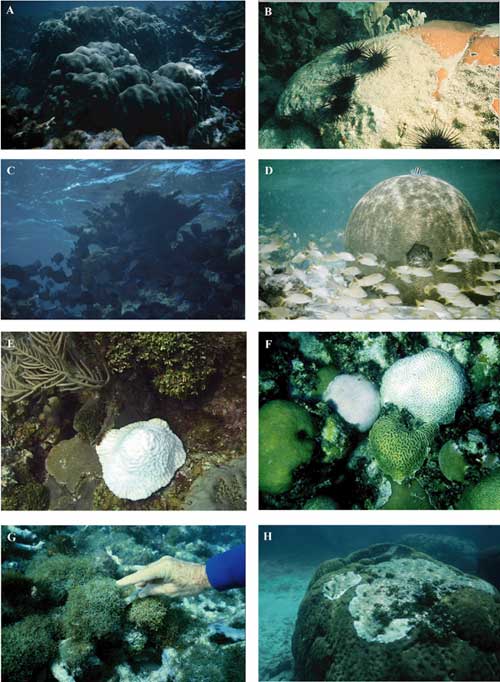FISC - St. Petersburg
Figure 4. Photos show other examples of healthy corals (A-D) and stressed or diseased corals (E-H). (A) Reef-framework builders Montastrea annularis (massive head coral, foreground) and Acropora palmata (platy moosehorn or elkhorn coral, background). (B) Black spiny sea urchin Diadema antillarum grazing a dead area on a species of Siderastrea before 1983. Though the coral is essentially dead, browsing urchins in a healthy reef keep the dead surface (foreground) free of algae. Live coral polyps are at upper right. Blades of live hydrocoral Millepora complanata are in the background. The Diadema population suffered a Caribbean-wide die-off in 1983-1984 from an unknown cause (Lessios et al., 1984) and from which it has not recovered. (C) Stand of healthy Acropora palmata. (D) Healthy Colpophyllia natans. (E) Bleached Meandrina species. A coral is said to bleach when it expels the symbiotic algae needed for photosynthesis, color, and to build its skeleton. Bleaching is a sign of stress, not a disease. If conditions that caused bleaching return to normal fairly rapidly, the coral will regain its symbiotic algae. If conditions do not allow bleaching to reverse, coral mortality may result. (F) Bleached Siderastrea (left) and Diploria species (right). (G) Typical overgrowth of turf algae on coral rubble in 1992 in Florida, nine years after demise of Diadema. Fleshy algal mats retard establishment of coral larvae. (H) White-band disease on a colony of Montastrea annularis. This and other types of band disease can destroy a 200-year-old coral in a single summer.
|
Can't see the printable PDF version? Get the free Adobe Acrobat® Reader. |
